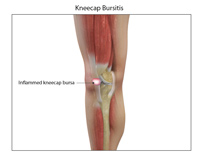
What is Bursa?
A bursa is a small fluid-filled sac found between soft tissues and bones. It lubricates and acts as a cushion to decrease friction between bones when they move.
What is Kneecap Bursitis?
Bursitis refers to the inflammation and swelling of the bursa. Inflammation of the bursa in front of the kneecap (patella) is known as kneecap bursitis or prepatellar bursitis.
Causes of Kneecap Bursitis
Kneecap bursitis is often caused due to
- Pressure applied on the knees with constant kneeling
- Conditions such as gout and rheumatoid arthritis
- Direct blow to the kneecap while playing sports such as basketball, football, and wrestling
- Infection
Symptoms of Kneecap Bursitis
Symptoms of kneecap bursitis include pain and swelling in front of the knee. You may also experience tenderness, warmth, and redness on the front of the knee.
Diagnosis of Kneecap Bursitis
Kneecap bursitis is diagnosed by reviewing your medical history and performing a thorough physical examination. Fluid from your bursa may be removed for lab analysis. Your doctor may order imaging studies, such as X-rays, MRI and CT scans to rule out other problems.
Treatment of Kneecap Bursitis
Kneecap bursitis can be effectively treated with conservative therapy where your doctor advises sufficient rest, use of ice packs and elevation of the affected leg to reduce inflammation. Anti-inflammatory drugs may also be prescribed to alleviate pain and swelling, and antibiotics for infections. Sometimes the bursa may be aspirated with a thin needle to remove fluid and reduce swelling or corticosteroids may be injected at the region of the inflamed bursa to relieve pain. Surgery is performed only when conservative treatment is ineffective, which involves the surgical removal of the bursa.
